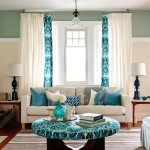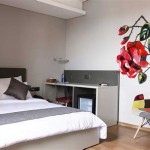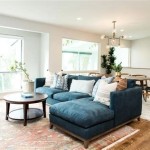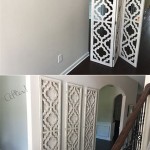How To Decorate a Room With Brown Walls
Brown walls present a unique decorating challenge, but also a wealth of opportunities to create a warm, inviting, and stylish space. Far from being limiting, brown, in its diverse shades, acts as a neutral backdrop that can support a variety of design aesthetics. The key to successfully decorating a room with brown walls lies in understanding the undertones of the brown, selecting complementary colors and textures, and thoughtfully incorporating lighting and accessories. This article will provide detailed guidance on how to navigate the decoration process and transform a room with brown walls into a comfortable and visually appealing environment.
Brown comes in a multitude of variations, each possessing distinct undertones that influence the overall feel of the room. Undertones can lean towards warm hues like red, orange, or yellow, or towards cooler hues like gray, green, or even purple. Identifying these undertones is the foundational step in selecting complementary colors for furniture, textiles, and accessories. A brown with warm undertones might pair well with other warm colors, while a brown with cool undertones could benefit from cooler or contrasting warmer shades. Ignoring the undertones can result in a color scheme that clashes or feels unbalanced.
Natural light plays a crucial role in how brown walls appear. In rooms with ample natural light, brown can appear richer and more vibrant. Conversely, in dimly lit rooms, brown can become somber and even oppressive. Understanding the light conditions is essential for making informed decisions about color palettes and lighting fixtures. Artificial lighting can be used to compensate for lack of natural light, highlighting specific areas and adding warmth or brightness as needed.
Key Point 1: Understanding Color Palettes and Complementary Colors
Choosing the right color palette is paramount when decorating a room with brown walls. Successful color palettes often rely on contrasting or complementary hues that either soften or enhance the brown's inherent qualities. Here are some examples of color palettes that work well with brown walls:
Neutral Palette: A neutral palette, using creams, beiges, off-whites, and grays, creates a sophisticated and serene atmosphere. These colors provide a subtle contrast to the brown walls, preventing the room from feeling monotonous. Incorporating varying textures within the neutral palette, such as linen, wool, and velvet, adds depth and visual interest. Consider layering different shades of cream or beige to create a more dynamic and engaging space. Metallic accents, such as gold or silver, can add a touch of elegance and visual sparkle.
Earthy Palette: An earthy palette embraces the natural tones that complement brown walls, creating a harmonious and grounded feel. This palette incorporates greens, oranges, reds, and yellows inspired by nature. For example, pairing brown walls with olive green accents can create a calming and organic atmosphere. Terracotta or burnt orange accents can add warmth and vibrancy. Using natural materials, such as wood, stone, and woven textiles, will further enhance the earthy aesthetic. Consider adding plants to bring life and freshness to the room.
Contrasting Palette: A contrasting palette uses bold colors to create a visually striking and energetic space. Colors like turquoise, teal, or even deep blues can provide a dramatic contrast against brown walls, creating a dynamic and stimulating environment. When using a contrasting palette, it's important to balance the boldness with neutral elements to prevent the room from feeling overwhelming. Consider using the contrasting color as an accent color, incorporating it in cushions, artwork, or accessories. A balanced application of the bold color can make a strong statement without overpowering the brown.
Monochromatic Palette: A monochromatic palette utilizes different shades and tints of brown to create a cohesive and sophisticated look. This approach involves layering various tones of brown, from light tans to dark chocolates, to add depth and visual interest. Incorporating different textures, such as velvet, leather, and wood, is crucial in a monochromatic scheme to prevent the room from feeling flat. Consider using patterns and prints in similar shades of brown to add subtle visual intrigue. The result is a calming and visually rich interior that showcases the versatility of brown.
When selecting a color palette, consider the room's purpose and desired mood. A bedroom might benefit from a calming neutral or earthy palette, while a living room might accommodate a bolder, contrasting palette. The key is to create a cohesive and harmonious color scheme that reflects individual style and preferences.
Key Point 2: Choosing Furniture and Accessories
The choice of furniture and accessories is crucial for successfully decorating a room with brown walls. The style, material, and color of these elements can significantly impact the overall aesthetic of the space. Here's a guide on how to choose furniture and accessories that complement brown walls:
Furniture Style: The chosen furniture style should align with the overall design aesthetic of the room. For a traditional look, opt for classic furniture pieces with ornate details and rich wood finishes. For a modern look, choose sleek and minimalist furniture with clean lines. For a bohemian look, consider eclectic pieces with mixed textures and patterns. The key is to select furniture that complements the brown walls without blending in completely. Choose pieces that offer a visual contrast in texture or color to create a more dynamic space.
Furniture Material: The choice of furniture material can significantly impact the overall texture and feel of the room. Leather furniture, especially in lighter shades, can provide a warm and inviting complement to brown walls. Wood furniture, in various finishes, can add a natural and organic touch. Upholstered furniture, in a range of fabrics, can introduce softness and comfort. Consider mixing different materials to add visual interest and depth. For example, pairing a leather sofa with wooden side tables and linen cushions can create a well-balanced and inviting space.
Accessories: Accessories are the finishing touches that bring a room to life. When decorating with brown walls, it is essential to choose accessories that complement the overall color palette and style. Artwork, mirrors, lamps, cushions, and rugs can all contribute to the aesthetic appeal of the room. Consider incorporating pops of color with accessories to add vibrancy and visual interest. For example, colorful cushions on a neutral sofa can brighten up the space. Mirrors can reflect light and make the room feel larger. Artwork can add personality and character. Rugs can define seating areas and add warmth and texture to the floor.
Metal Accents: Metallic accents can add a touch of elegance and sophistication to a room with brown walls. Gold, silver, and bronze accents can complement the warmth of the brown, adding a subtle shimmer and visual interest. Consider incorporating metallic accents in lamps, picture frames, or decorative objects. The key is to use metallic accents sparingly to avoid overwhelming the space. A few well-placed metallic accents can add a touch of glamour and elevate the overall aesthetic of the room.
When selecting furniture and accessories, consider the scale and proportion of the pieces. Choose furniture that is appropriately sized for the room, avoiding pieces that are too large or too small. Arrange furniture in a way that promotes conversation and flow. Accessorize carefully, avoiding clutter and creating a cohesive and visually appealing space.
Key Point 3: Lighting and Ambience
Lighting plays a vital role in transforming a room with brown walls from potentially dark and dreary to inviting and sophisticated. The right lighting not only illuminates the space but also enhances the color palette, highlights architectural features, and creates a desired ambience. Here’s a guide on how to optimize lighting in a room with brown walls:
Natural Light: Maximizing natural light is crucial in a room with brown walls. Keep windows unobstructed and consider using sheer curtains or blinds to allow natural light to filter into the room. Mirrors can be strategically placed to reflect natural light and brighten up dark corners. If natural light is limited, consider increasing the amount of artificial lighting to compensate.
Layered Lighting: Layered lighting involves using a combination of different types of lighting fixtures to create a well-lit and balanced space. This includes ambient lighting, task lighting, and accent lighting. Ambient lighting provides overall illumination, while task lighting provides focused light for specific activities, such as reading or working. Accent lighting highlights architectural features or artwork, adding depth and visual interest.
Ambient Lighting: Ambient lighting can be achieved through overhead fixtures, such as chandeliers or pendant lights. Choose fixtures that provide sufficient light to illuminate the entire room. Consider using dimmer switches to adjust the light level and create a desired ambience. For a room with brown walls, warm-toned light bulbs can help to enhance the warmth and create a cozy atmosphere. Avoid using harsh or cold-toned light bulbs, as they can make the brown walls appear dull and uninviting.
Task Lighting: Task lighting is essential for functional areas, such as desks, reading nooks, or kitchen counters. Desk lamps, floor lamps, and under-cabinet lighting can provide focused light for specific tasks. Choose fixtures that are adjustable and provide adequate light without glare. Consider the style of the fixtures and choose pieces that complement the overall design aesthetic of the room.
Accent Lighting: Accent lighting can be used to highlight architectural features, artwork, or decorative objects. Spotlights, track lighting, and wall sconces can be used to create dramatic effects and add visual interest. Consider using accent lighting to highlight a favorite piece of artwork or to create a focal point in the room. Accent lighting can also be used to create a sense of depth and dimension, making the room feel larger and more inviting.
Warm vs. Cool Lighting: When selecting light bulbs, consider the color temperature and choose bulbs that complement the brown walls. Warm-toned light bulbs (2700K-3000K) can enhance the warmth of the brown and create a cozy atmosphere. Cool-toned light bulbs (3500K-4000K) can provide a brighter and more energizing light. In general, warm-toned light bulbs are best suited for living rooms and bedrooms, while cool-toned light bulbs are better suited for kitchens and bathrooms.
Decorative Lighting: Decorative lighting fixtures can add a touch of personality and style to a room with brown walls. Chandeliers, pendant lights, and sconces can be used to enhance the overall aesthetic of the space. Choose fixtures that complement the furniture and accessories, and consider the scale and proportion of the pieces. Decorative lighting can also be used to create a focal point in the room, drawing the eye and adding visual interest.

Rustic Bedroom Decor Vintage Ladder

Color Guide How To Work With Brown

23 Brown Bedroom Decor Ideas

How To Decorate A Bedroom With Brown Walls

11 Trendy Brown Living Room Ideas 2025 Checkatrade

Decorating With Color Deep Toned Walls

11 Trendy Brown Living Room Ideas 2025 Checkatrade

How To Decorate With Brown Paint The Bold Place

Full Spectrum Color For A Cozy Living Room

11 Trendy Brown Living Room Ideas 2025 Checkatrade
Related Posts







